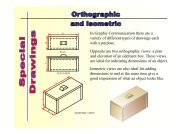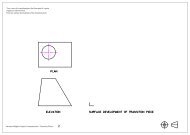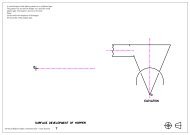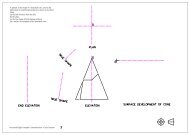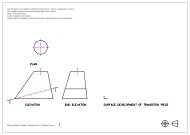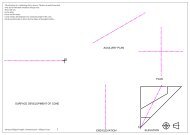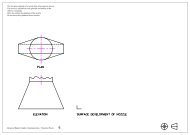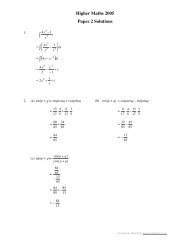Integrating sinx & cosx
Integrating sinx & cosx
Integrating sinx & cosx
You also want an ePaper? Increase the reach of your titles
YUMPU automatically turns print PDFs into web optimized ePapers that Google loves.
<strong>Integrating</strong> <strong>sinx</strong> & <strong>cosx</strong>If y = <strong>sinx</strong> thendy/ dx= <strong>cosx</strong>So∫ <strong>cosx</strong> dx = <strong>sinx</strong> + CIf y = -<strong>cosx</strong> thendy/ dx= <strong>sinx</strong>So∫ <strong>sinx</strong> dx = -<strong>cosx</strong> + CExample∫ (3<strong>cosx</strong> – 4<strong>sinx</strong>) dx =3<strong>sinx</strong> + 4<strong>cosx</strong> + C
Example∫π/ 3/0 3<strong>sinx</strong> dx = [-3<strong>cosx</strong> ]30π= (-3cos π / 3) - (-3cos0)Example= (-3 X ½ ) – (-3 X 1)= -1 1 / 2+ 3= 1 1 / 2Find the totalshaded area.π3π/ 2y = <strong>sinx</strong>
π1 st area = ∫ <strong>sinx</strong> dx0= [ -<strong>cosx</strong> ] 0π= -cosπ - (- cos0)= -(-1) – ( -1)= 23π/ 22nd area = ∫ <strong>sinx</strong> dxπ= [ -<strong>cosx</strong> ]π3π/ 2= -cos 3 π / 2- (- cos π)= 0 - 1= -1 (actual area = 1)So total area = 2 + 1 = 3units 2alternativelyBy symmetry,2 nd area = ½ of first = 1 etc.
Example Show that the shaded area = 2√2units 2 .y = <strong>cosx</strong>y = <strong>sinx</strong>Limits Curves meet when <strong>sinx</strong> = <strong>cosx</strong><strong>sinx</strong> = <strong>cosx</strong><strong>cosx</strong> <strong>cosx</strong>tanx = 1x = π / 4or 5 π / 4Q1 & Q3tan -1 1 = π / 4
Between π/ 4and 5 π / 4the sin graph is higherSo shaded area = ∫ π/ 45π/ 4( <strong>sinx</strong> – <strong>cosx</strong> )dx= [ -<strong>cosx</strong> - <strong>sinx</strong> ]5π/ 4π/ 4= ( -cos 5 π / 4- sin 5 π / 4) - (-cos π / 4- sin π / 4)= ( 1 / √2+ 1 / √2 ) - (- 1 / √2- 1 / √2 )= 1 / √2+ 1 / √2+ 1 / √2+ 1 / √2= 4 / √2= 4 X √2√2 X √2= 4√22= 2√2units 2



